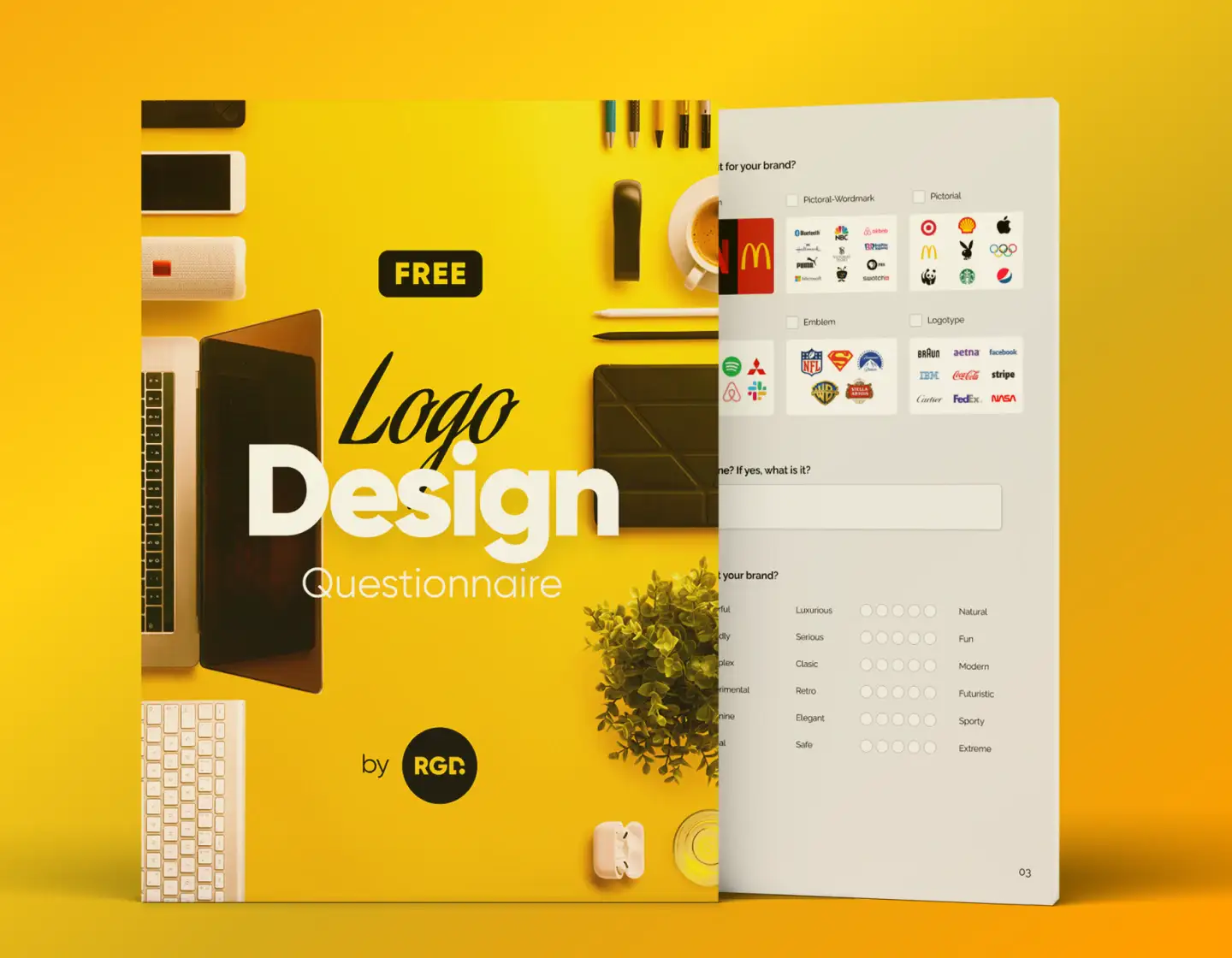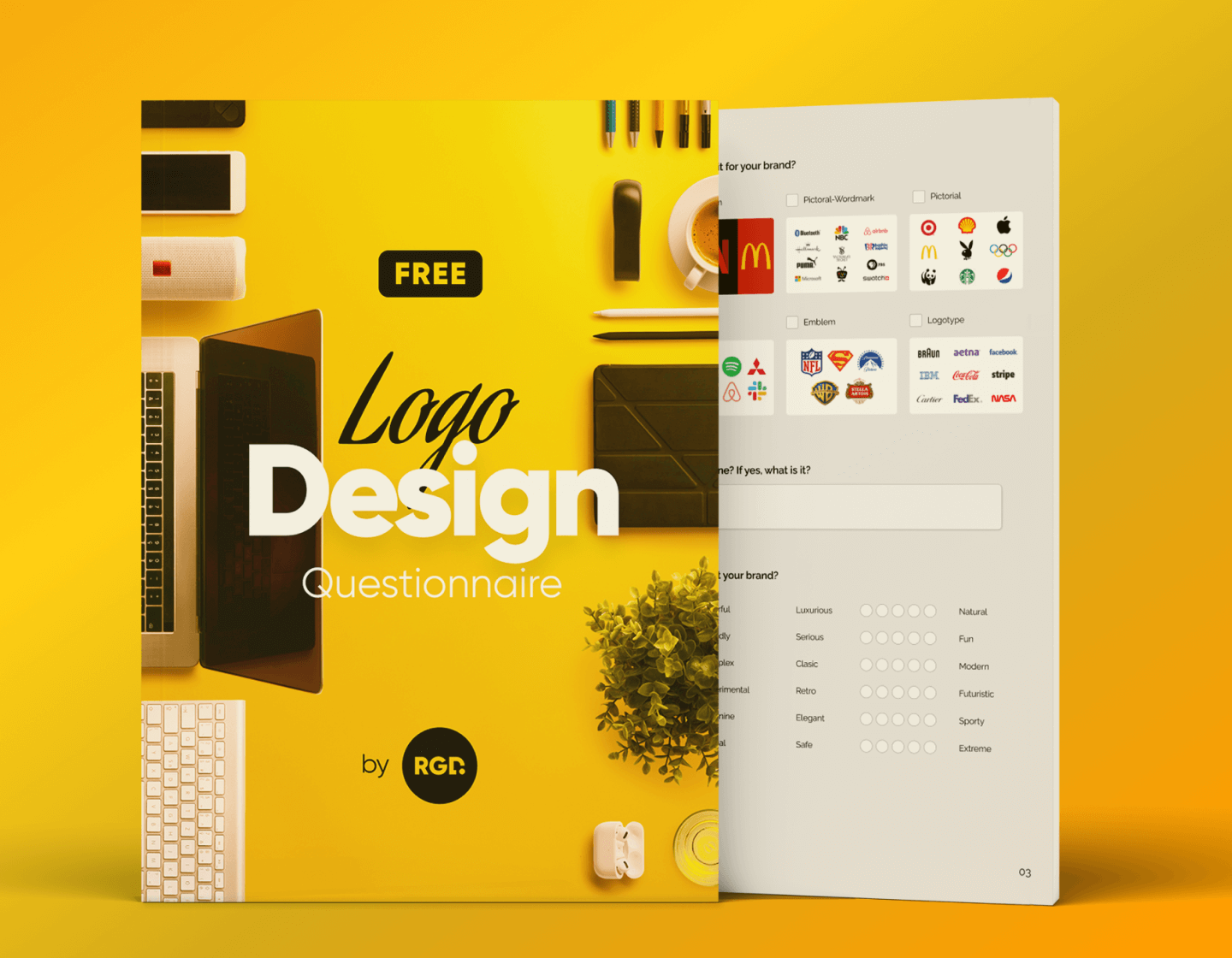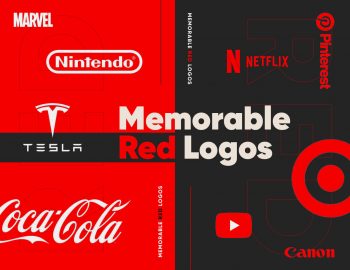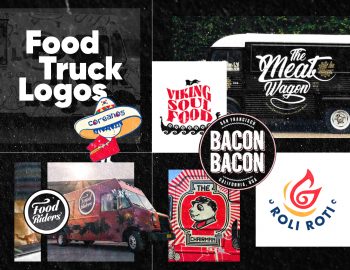If you’ve ever gone back and forth with a client trying to get the right info for a logo project, you know how messy it can get. That’s why today I’ll be sharing an interactive PDF Logo Design Questionnaire free template that your clients can fill out digitally, check multiple-choice answers, and basically make your life easier.
Since it’s a PDF, you can also edit it in Illustrator, tweak the questions, or add your own follow-ups if needed. Below the template section, I’ll also break down why each question matters, what kind of info to look for, and how it all helps create the perfect logo, with real examples along the way.
Grab the template, save yourself some headaches, and let’s dive in!
Logo Design Questionnaire Free Template
This is a 30-question logo design questionnaire in PDF with open questions and multiple-choice questions. I even added some visual examples so your client will know exactly what you mean by “monogram”, “wordmark” and other designer terms.
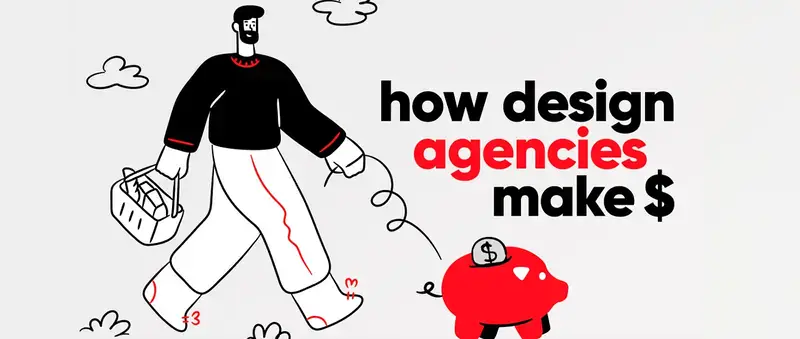
What Questions To Include?
With the template out of the way, I recommend you keep reading because here I will explain the purpose of each individual question. It may give you ideas for some additional follow-up questions if you decide to customize your questionnaire for a specific client.
What is the name of your business?
📌 Why Ask: This might seem obvious, but the name of the business plays a huge role in how you design the logo. A long name usually works better with a simple wordmark or monogram, and a short name allows it to be paired with a strong symbol. The name itself can also hint at visual themes—for example, a business named “Blue Wave Marketing” might inspire wave-like elements in the design.
What products or services do you offer?
📌 Why Ask: A logo should reflect what your client’s business does, even in a subtle way. If your client offers multiple products or services, you can make the logo broad enough to represent everything without being too specific. For something more specific like selling handmade wooden furniture, you will know to incorporate warm, natural colors and a font with a handcrafted feel, instead of something futuristic or corporate-looking.
What is your unique selling point?
📌 Why Ask: If the business prides itself on being eco-friendly, luxury-focused, or the most affordable option, that can influence your design choices. Let’s say you’re designing a logo for a coffee shop owner whose coffee is the strongest in town. You can use this unique selling point to present the power of the coffee with a symbol like a skull or lightning bolt, for example.
Who is your ideal customer?
📌 Why Ask: Whoever is the target customer, the logo will speak directly to them. A logo for a kids’ toy brand will look completely different from one for a luxury real estate agency.
How would you describe your brand’s personality in three words?
📌 Why Ask: If your client describes their brand as “playful, bold, and energetic,” the logo will obviously look very different from one that’s “sophisticated, minimalist, and timeless.” I do recommend that you should consider giving your client multiple variants to choose from to avoid contradictions like “classy, playful, modern, and timeless”.
If your brand were a person, how would you describe their style and tone?
📌 Why Ask: This will further help you nail the right direction. Descriptions like “a cool, stylish trendsetter”; “a friendly, down-to-earth neighbor”; “a confident CEO who wears tailored suits” or “a laid-back artist who loves vintage records” give a lot of hints.
What feelings or values do you want your brand to evoke?
📌 Why Ask: This refers to the emotional connection between a brand and its audience. This may be trust, excitement, adventure, calmness, or anything else, really.
Do you want your brand to fit within your industry’s common aesthetic or stand apart?
📌 Why Ask: Some brands want to blend in with industry norms (for recognition), but others will want to disrupt the space. If you know this you will be able to avoid designs that feel too generic or, on the flip side, too disconnected.
Who are your competitors? (Provide links if possible)
📌 Why Ask: This question aims to help you see what works, what doesn’t, and what gaps exist in the market and to create something that positions the brand either by aligning with industry expectations or standing out.
What do you like or dislike about their branding?
📌 Why Ask: This gives you insight into the client’s preferences and will help you avoid repeating mistakes seen in other brands.
Are there any brands (inside or outside your industry) whose style you admire?
📌 Why Ask: This will help you understand your client’s taste and what kind of visual impact they want.
Do you have an existing logo, or is this a new identity?
📌 Why Ask: If there’s an existing logo, you will also need to learn if you have to refine it or create something completely new. Also if you need to keep certain recognizable elements for brand consistency.
What do you like or dislike about your current logo (if applicable)?
📌 Why Ask: If your client has a logo but wants to change it, you will learn what works (or doesn’t) to avoid repeating past mistakes or removing elements the client actually likes.
Do you have any specific ideas for your new logo?
📌 Why Ask: Some clients come in with clear ideas, but most will be open to exploration. If they don’t have anything specific in mind, this question will give them the freedom to start from somewhere.
Do you want a logo with only text, text + symbol, or just a symbol?
- Monogram / Lettermark
- Wordmark Logo
- Letterform Logo
- Pictoral-Wordmark Logo
- Pictorial Logo
- Mascot Logo
- Abstract Logo
- Emblem Logo
📌 Why Ask: Different logo formats serve different purposes. Keep in mind that your client may not be able to visualize these options so give them examples for each type.
Does your logo need to include a tagline? If yes, what is it?
📌 Why Ask: Learn if there is a tagline as part of the logo because it will affect the layout and readability. Some taglines are short and easy to integrate, but the longer ones might need variations where they’re separate. Discuss this with your client.
Which logo styles do you feel best suit your brand?
📌 Why Ask: Some industries lean toward certain styles, but personal preference and brand personality also play a role. Here you can either give them multiple choices or create a scale with complete opposites to avoid contradicting answers. For example, a couple of scales from greyscale to colorful, from minimalistic to complex, from elegant to sporty, etc.
Are there any particular shapes or symbols you associate with your brand?
📌 Why Ask: Some brands have strong visual associations and asking this question will help you learn about any meaningful symbolism.
Are there any design elements you want to avoid?
📌 Why Ask: This will give you info about what your client dislikes in terms of certain colors, fonts, or styles.
Are there existing brand guidelines we should follow?
📌 Why Ask: If your client already has a visual identity (specific fonts, colors, or styles), half of your research is done because the new logo should align with it.
Do you have a preferred font style?
- Serif
- Sans Serif
- Slab Serif
- Display
- Script
- Handwritten
- Monospaced
- Typewriter
- Novelty
📌 Why Ask: You obviously know what each font style does for a logo, but your client might not. You can explain it to them visually if you include examples for each style below the question. They will catch the vibe immediately.
Do you want a custom typeface or a standard font?
📌 Why Ask: Some brands need that uniqueness, while others are fine with a well-chosen existing font. Either way, it all depends on your client’s preferences.
What colors do you feel represent your brand?
📌 Why Ask: To set the tone of the brand and help you choose the proper palette.
Do you want a monochrome version of your logo?
📌 Why Ask: Let your client know that the black-and-white version of the logo is more versatile for different uses, like printing on receipts, embossing, or engraving. This is, of course, only when the logo doesn’t rely too much on its colors.
Where will the logo be used?
You can make it a multiple-choice question and add some of the following:
🔘 Online.: Website, email marketing, social media profiles, social media ads, mobile apps, digital presentations, YouTube channel, e-commerce platforms (Amazon, Etsy, Shopify), online courses, webinars, digital brochures
🔘 Brand Identity.: Business cards, envelopes, letterheads, stationery, invoices, contracts, signage, storefront displays, company uniforms, employee ID badges
🔘 Product Packaging.: Product labels, shipping boxes, shopping bags, promotional flyers, gift wrap, stickers, price tags, custom tissue paper
🔘 Promotional Materials.: Mugs, t-shirts, tote bags, hats, water bottles, pens, notebooks, keychains, posters, banners, trade show booths, vehicle wraps, billboards
📌 Why Ask: A logo needs to work well in different environments and scale properly. Of course, the safest option is to plan for all cases, however, if your client doesn’t need to use it in clothing tags or package design, for example, you won’t need to overdo it.
What file formats do you need?
If you’re working with the end client, chances are they won’t be sure which format fits what purpose. This is why consider giving them multiple choices with a quick explanation for each format.
- JPEG (.jpg). Best for web use, social media, and non-transparent backgrounds (compressed, smaller file size).
- PNG (.png).Ideal for web use when a transparent background is needed (logos for websites, overlays, or watermarks).
- SVG (.svg). Scalable vector format for web and digital applications (great for responsive designs, websites, and apps).
- AI (.ai). Adobe Illustrator file, fully editable and best for future modifications (preferred for professional printing and vector-based designs).
- PDF (.pdf). High-quality format for print and sharing, ensuring the logo looks sharp (useful for business documents, invoices, and presentations).
- EPS (.eps). Vector format used for large-scale printing (banners, signage, billboards, and professional printing needs).
- TIFF (.tiff). High-resolution format for print use (rarely needed but useful for some high-quality printing applications).
📌 Why Ask: A restaurant needing a logo for a website, menus, and signage should have a mix of formats—PNG for digital, PDF for printing, and AI for future resizing. A YouTuber who only needs a logo for their channel banner and thumbnails might just need a PNG and SVG. Asking this question prevents the client from coming back later after realizing they need a different file type.
Do you have a preferred logo dimension? (Square, Horizontal, Vertical, or all variants)
Horizontal logos are great for website headers, while square or vertical logos work better for social media or packaging. If you ask your client for their preferences upfront it can help avoid resizing issues later.
What is your budget range?
📌 Why Ask: A higher budget allows for custom illustrations and multiple revisions, while a lower budget might mean working with pre-made fonts and limited revisions. It all depends on your work. This question will often open a conversation about your rates.
What is your deadline for this project?
📌 Why Ask: So you’ll know if you need to add a rush fee in case the client gives you a very tight deadline but a very complex logo project.
Do you need additional branding services, such as business cards, letterheads, social media graphics, or brand guidelines?
📌 Why Ask: Your client may need matching business cards, a social media kit, or brand guidelines, and it’s better to plan for that upfront rather than treating them as last-minute additions.
Are there any final comments, requests, or concerns?
📌 Why Ask: Sometimes, clients have specific requests they haven’t mentioned yet—like needing extra versions for seasonal promotions or something else. This open-ended question gives them a chance to share any final thoughts before the project begins. A nonprofit might mention, “We’d like a version of the logo with a ribbon incorporated for Breast Cancer Awareness Month.” A sports team might add, “Can we get an animated version for our video intros?” These details will save you surprises later.
And there you have it– A solid logo starts with the right questions, and this questionnaire makes sure you’re getting all the details upfront—without endless email threads. Plus, since it’s an interactive PDF, your clients can fill it out easily, and you can tweak it to fit your process.
There are even more free templates you can get:


